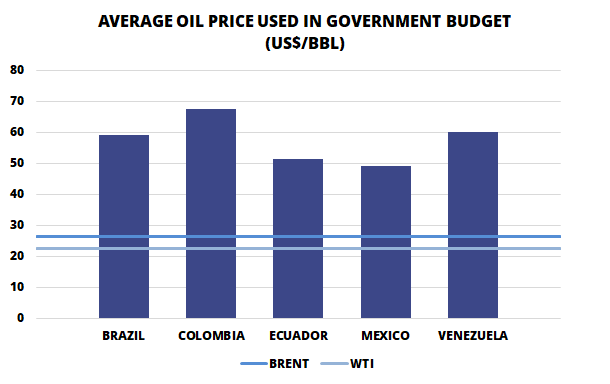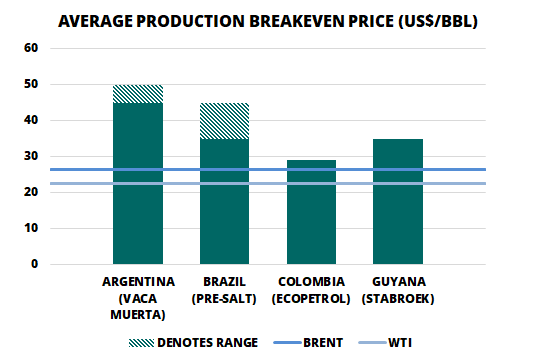China, India & Colombia’s Interbolsa
Colombian firm Interbolsa is being liquidated in a move to protect the interests of Colombia’s financial markets.
In recent weeks, global energy markets have been rocked by a perfect storm, buffeted on two fronts by market gusts of historic magnitude. On March 6, a fragile deal of several years between Russia and Saudi Arabia-led OPEC collapsed as the sides failed to reach an agreement on continued supply cuts and instead vowed to raise production in a battle for market share. Meanwhile, as the Covid-19 outbreak reached pandemic proportions, the world entered lockdown and much economic activity skidded to a halt. On March 18, the Brent crude global benchmark dropped below $25 per barrel, its lowest level since 2003. Depending on the length of the price collapse and the pandemic, the effects could be dire for oil-dependent Latin American economies. Meanwhile, the economic contraction will reduce demand for power and limit access to finance for renewable energy projects.
Following several years of sluggish economic growth and increasing fiscal stress in the region, low crude prices will have immediate consequences on public coffers in Latin America’s oil export-dependent economies. Government budgets depend on projected oil prices that are generally much higher than the current price (see Figure 1). The governments of Venezuela and Ecuador are most vulnerable. Upstream investment will also be curtailed because international oil prices are well below breakeven prices (those required to recover costs of production) across the region (see Figure 2). Most projects that are already producing will not be shut in as a result of temporary low oil prices when the long-term economics are still favorable. However, with companies capital-constrained, investment in exploration will be slashed. Argentina and Brazil have among the highest breakeven prices for their most promising reserves.
 |
Figure 1: Current oil prices are well below the estimates used to determine government spending across the region. Brent and WTI closing prices for 3/26/20 shown.
Source: News reports
Venezuela will be hardest hit. Already beset by falling production and US sanctions that restrict its potential buyers, state-owned PDVSA has been forced to sell its crude at steep discounts. PDVSA has been selling its flagship Merey heavy crude blend at discounts of as much as $23 below the Brent international benchmark. Venezuela has very low lifting costs— $10-$12/barrel on average, with some fields as low as $5/barrel—but when shipping costs to Asia and royalties are added, PDVSA is making no profit at today’s prices, and production will likely be shut in when storage reaches capacity.
Ecuador, one of the countries in the region most dependent on oil revenues, was already in a fiscal straitjacket before this new blow. The dollarization of its economy deprives the country of monetary policy tools and gives the government little choice but to invoke austerity and seek emergency funding and the understanding of the IMF, with which it is engaged in a $4.2 billion loan program.
In Argentina’s emerging Vaca Muerta shale play, investment was already frozen due to perceived political risk following the election of President Alberto Fernández. With a relatively high breakeven price of $45-50 per barrel, investment there will remain stalled if prices do not recover. The government of Neuquén Province, home to Vaca Muerta, has called on the national government to guarantee a minimum crude price to producers, but it is hard to see that happening when Argentina is seeking to renegotiate debt payments to the IMF and private lenders to avoid default.
In Brazil’s pre-salt, expected to be one of the world’s largest sources of supply growth in coming years, the breakeven is $35-45 per barrel. Energy consultancy Wood Mackenzie has predicted that 2020 exploration budgets in the country will be slashed by 20 percent. The government was already considering holding off on new bid rounds since so much acreage has been awarded in recent years, so new rounds are now even less likely.
 |
Figure 2: Current oil prices are below the breakeven prices required for several countries’ most promising fields. Brent and WTI closing prices for 3/26/20 shown.
Source: News reports
In Colombia, shale is seen as the best hope of boosting the country’s reserves, which will last for about 7.8 years at current production rates. But a public debate over whether to allow fracking is now compounded by the technique’s higher cost, uneconomical under current prices. As a result, the prospects for developing unconventionals in Colombia have disappeared for the time being.
Mexico will not feel the effects of low oil prices as acutely this year thanks to its annual oil hedge, which covered 2020 government oil revenues by locking in a price of $49/barrel for an undisclosed number of barrels. The greater concern is the health of state oil giant Pemex, which owes $6 billion on maturing bonds this year alone. The company’s Maya crude closed at less than $13 per barrel for shipments to the US Gulf Coast on March 18. It appears increasingly likely that a second ratings agency will downgrade Pemex bonds to junk, as Fitch did in June 2019, which could lead to a firesale. The increasingly ailing Pemex, traditionally the source of a large share of government revenue (around 17 percent this year), will further strain Mexico’s public finances beyond 2020.
Finally, the oil price crash and coronavirus have compounded an inauspicious start to oil production in Guyana, which was previously projected to experience economic growth of 86 percent this year. Fierce controversy over the vote-counting process following the election of March 2 has still not been resolved. The price drop is not expected to affect development of ExxonMobil’s Liza 1 well. However, market uncertainty has caused the government to extend, for the second time, a deadline for companies to submit bids to market the government’s share of oil from the Stabroek block, where Exxon is already producing.
The Covid-19 catastrophe could also have negative impacts on Latin America’s power and renewable energy sector. Electricity demand will decline amid the economic contraction. Governments may delay long-term auctions for renewable energy supply, which are reportedly behind 80 percent of current renewable energy capacity in the region and have led to rapid growth in renewable energy investment at prices competitive with fossil fuel generation. Significant disruptions in global supply chains due to the pandemic will cause delays and some ongoing projects will seek to declare force majeure. Financing may dry up in the short term as future demand is uncertain and investors flee to safer assets. According to our analysis, even before the current crisis, many renewable energy projects in Latin America had been delayed, in many cases due to lack of access to financing. Renewable energy developers face greater risk where power-purchase agreements (PPAs) are priced in local currency or the buyer is a state utility with weak finances. Low oil prices also reduce the cost of oil-fired electricity generation vis-à-vis renewable energy generation. Natural gas prices have also plummeted since November, and could continue to sink. On the other hand, sustained low oil prices may make the rate of return of developing renewable energy projects competitive with that of hydrocarbon development.
Latin America’s energy markets will experience turbulence for as long as low oil prices and Covid-19 persist, and will continue to be jolted by aftereffects even after the storm has abated. The impacts on the energy sector have already begun to bleed over into the economy at large and into politics, and will continue to do so. Oil development will slow and government revenues will suffer as a result, serving as yet another warning of the dangers of overdependence on the region’s natural resources. The only silver lining is the hope that the region will be better prepared when the next storm comes.
Covid-19 in the Americas: The Dialogue’s Coronavirus Updates
Covid-19 in the Americas: The Dialogue's Coronavirus Updates
Examining Implications of Covid-19 and Low Oil Prices for Latin American Energy
Colombian firm Interbolsa is being liquidated in a move to protect the interests of Colombia’s financial markets.
China has became a critical economic partner for Venezuela over the past decade.
Chinese lending to Latin America and the Caribbean hit an all-time high of $37 billion in 2010.